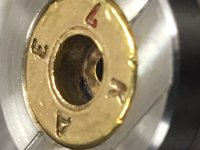Not necessarily. Using shell holders made by one firm with dies built by another can result in a case that's had the shoulder set back too far...ie. producing a headspace problem.
It was settled and decided upon long before the Internet; The universal deck height of the shell holder is .125", I have two sets of C&H dies from the '60s in counter display boxes that have the instructions printed on the bottom of the box. The Instructions read; "The dies in this box are designed to be used with a shell holder with a height of .125" ". I added the 'deck' part. And I always ask: Who measures?
And then there is that 'THINK ABOUT IT THING', we have reloaders that are purchasing a set of 5 sell holders for $40.00+ that do not have a deck height of .125".
And then there is head space for the case, my cases do not have head space, I off set the length of the chamber with the length of the case from the shoulder to the case head and I find it impossible to move the shoulder back with a die that has case body support.
F. Guffey


